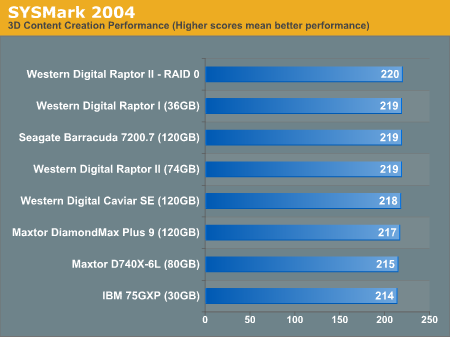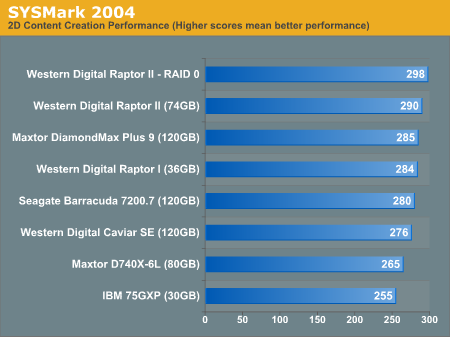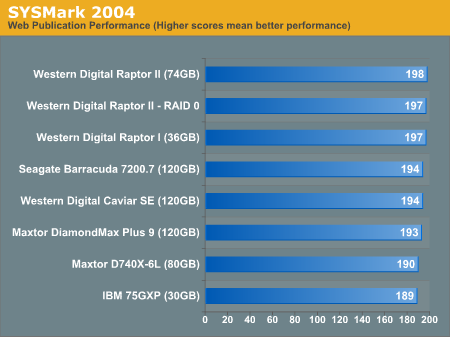Western Digital's Raptors in RAID-0: Are two drives better than one?
by Anand Lal Shimpi on July 1, 2004 12:00 PM EST- Posted in
- Storage
Overall System Performance - SYSMark
SYSMark 2004 is divided into two separate suites: Internet Content Creation and Office Productivity. What makes SYSMark an ideal hard disk benchmark is that its scores are totals of response times, meaning that the benchmark measures how long the system takes to respond to a task (e.g. how long before a search and replace is completed after it is initiated) and sums up all such response times to generate a score. This score is generated for six total subcategories: three under Internet Content Creation and three under Office Productivity.For the most part, SYSMark is CPU/platform bound, but we will see some variations in performance according to disk speed. At the same time, there are a couple of benchmarks within SYSMark that are heavily disk dependent.
First, we start with Internet Content Creation performance; the first category that we will deal with is 3D Content Creation. The tests that make up this benchmark are described below:
"The user renders a 3D model to a bitmap using 3ds max 5.1, while preparing web pages in Dreamweaver MX. Then the user renders a 3D animation in a vector graphics format."

As we've seen in the past, 3D content creation performance is rarely influenced by hard disk speed (unless your workstation is grossly underpowered in memory size), and thus, we see no improvement from a two-drive RAID-0 array.
Next, we have 2D Content Creation performance:
"The user uses Premiere 6.5 to create a movie from several raw input movie cuts and sound cuts and starts exporting it. While waiting on this operation, the user imports the rendered image into Photoshop 7.01, modifies it and saves the results. Once the movie is assembled, the user edits it and creates special effects using After Effects 5.5."

There's a small 2.8% performance boost from RAID-0 here, but once again, nothing to write home about and nothing worth the added cost.
The Internet Content Creation suite is rounded up with a Web Publishing performance test:
"The user extracts content from an archive using WinZip 8.1. Meanwhile, he uses Flash MX to open the exported 3D vector graphics file. He modifies it by including other pictures and optimizes it for faster animation. The final movie with the special effects is then compressed using Windows Media Encoder 9 series in a format that can be broadcast over broadband Internet. The web site is given the final touches in Dreamweaver MX and the system is scanned by VirusScan 7.0."

Once again, we're left with virtually identical performance between the RAID-0 and single drive Raptor configurations. The average of our three SYSMark runs have actually left the single drive Raptor II slightly ahead of the RAID-0 array, but that's normal variation between the benchmark runs.










127 Comments
View All Comments
Insomniac - Thursday, July 1, 2004 - link
I was wondering how RAID1 reads back data. I thought if it was smart, it would use both drives and improve performance. If that wasn't the case, I wondered if you could choose which drive it read from. That way, you could get a WD Raptor II and a low cost 80GB hard drive to pair up. You get the redundancy and speed of the Raptor for a lower cost. What about RAID5? (I know the ICH5/6 doesn't support it, but I thought there were some chipset m,akers that did. I would like to see what that brings to the mix. Given the choice right now, I'd take redundancy over performance. Maybe RAID 5 can give you both for less than 0+1.Pollock - Thursday, July 1, 2004 - link
I really wish some regular 7200 RPM drives had been used, considering someone who can afford a 74GB Raptor won't care about the costs of RAID anyway. =P Besides, to me it seems like Raptors already perform so well that it's hard to find any performance gain anyway. I was also under the impression that a lot of people with SATA drives in RAID 0 were actually getting much more noticeable performance gains; i.e. outperforming lone Raptors. Well, whatever.goku21 - Thursday, July 1, 2004 - link
I noticed that they came to the conclusion of only using 2 drives in a RAID setup, but in my expereince the more drives the supposed increase in performance. Perhaps they should revisit this with 4 Raptors in a RAID setup.kuk - Thursday, July 1, 2004 - link
Just one small thingy ... why is the manufaturer stated in the article summary "3Com/U.S. Robotics"?parrybj - Thursday, July 1, 2004 - link
While your overall disk bound throughput may be higher, seek times are sill only as fast as the slowest drive in the array. Since seek time is a more important desktop performance metric, I would think there would be very little benefit to doing this.Marlin1975 - Thursday, July 1, 2004 - link
Well the review was nice if you are thinking of running 2 raptors on a ICH5/6 SATA ports, but what about the other 99% of use that may use VIA, SiS, etc.. and/or other 7200 rpm hard drives?Matthew Daws - Thursday, July 1, 2004 - link
I'd be interested in seeing how using RAID0 with older drives, or one old drive and a newer drive, works out. If you're upgrading your motherboard, then given that RAID comes "for free", it could be a good way to save money by buying a second, smallish hard-drive, and using your old hard-drive with this new one in parallel...parrybj - Thursday, July 1, 2004 - link
Very good article. The results are not surprising. I have one comment about RAID1. While in theory it is simply a data redundancy mechanism, in practice there are performance benefits. Any good RAID1 algorithm will use read optimizations that will allow for parallellism during read requests. Thus, under the right conditions, most RAID1 arrays will achieve higher read IOPS than a single drive. Also, there may be a performance hit on writes due to the fact that writes will only be as fast as the slowest drive.djm2cmu - Thursday, July 1, 2004 - link
#4: Excellent introduction to all the common RAID levels here: http://www.acnc.com/04_01_00.htmlnofuse - Thursday, July 1, 2004 - link
This article doesn't seem to be up to the standards I've come to expect from Anandtech.It would be more fair to say "Intel's onboard RAID 0 solution offers no performance gain." I'd be interested to see results from other RAID controllers. You can't take one product and make a blanket comment like "RAID 0 is not worth it." That would be like me reviewing an NVIDIA Vanta graphics card and saying "3D acceleration is not worth it."